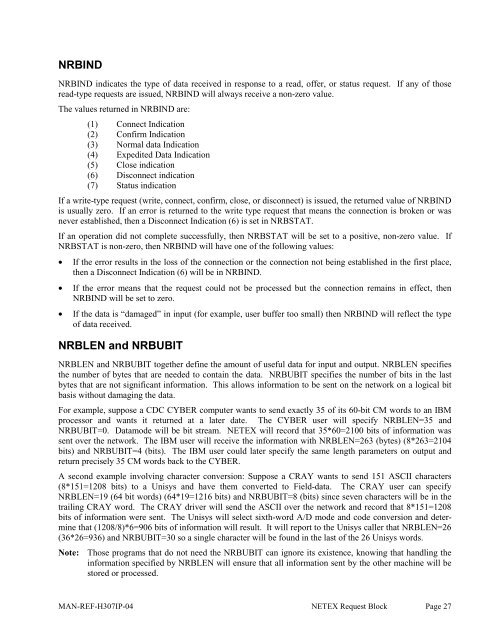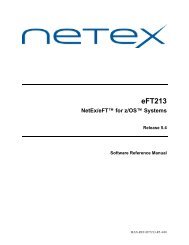SDISC Assembler Call - NetEx
SDISC Assembler Call - NetEx
SDISC Assembler Call - NetEx
- No tags were found...
You also want an ePaper? Increase the reach of your titles
YUMPU automatically turns print PDFs into web optimized ePapers that Google loves.
NRBINDNRBIND indicates the type of data received in response to a read, offer, or status request. If any of thoseread-type requests are issued, NRBIND will always receive a non-zero value.The values returned in NRBIND are:(1) Connect Indication(2) Confirm Indication(3) Normal data Indication(4) Expedited Data Indication(5) Close indication(6) Disconnect indication(7) Status indicationIf a write-type request (write, connect, confirm, close, or disconnect) is issued, the returned value of NRBINDis usually zero. If an error is returned to the write type request that means the connection is broken or wasnever established, then a Disconnect Indication (6) is set in NRBSTAT.If an operation did not complete successfully, then NRBSTAT will be set to a positive, non-zero value. IfNRBSTAT is non-zero, then NRBIND will have one of the following values:• If the error results in the loss of the connection or the connection not being established in the first place,then a Disconnect Indication (6) will be in NRBIND.• If the error means that the request could not be processed but the connection remains in effect, thenNRBIND will be set to zero.• If the data is “damaged” in input (for example, user buffer too small) then NRBIND will reflect the typeof data received.NRBLEN and NRBUBITNRBLEN and NRBUBIT together define the amount of useful data for input and output. NRBLEN specifiesthe number of bytes that are needed to contain the data. NRBUBIT specifies the number of bits in the lastbytes that are not significant information. This allows information to be sent on the network on a logical bitbasis without damaging the data.For example, suppose a CDC CYBER computer wants to send exactly 35 of its 60-bit CM words to an IBMprocessor and wants it returned at a later date. The CYBER user will specify NRBLEN=35 andNRBUBIT=0. Datamode will be bit stream. NETEX will record that 35*60=2100 bits of information wassent over the network. The IBM user will receive the information with NRBLEN=263 (bytes) (8*263=2104bits) and NRBUBIT=4 (bits). The IBM user could later specify the same length parameters on output andreturn precisely 35 CM words back to the CYBER.A second example involving character conversion: Suppose a CRAY wants to send 151 ASCII characters(8*151=1208 bits) to a Unisys and have them converted to Field-data. The CRAY user can specifyNRBLEN=19 (64 bit words) (64*19=1216 bits) and NRBUBIT=8 (bits) since seven characters will be in thetrailing CRAY word. The CRAY driver will send the ASCII over the network and record that 8*151=1208bits of information were sent. The Unisys will select sixth-word A/D mode and code conversion and determinethat (1208/8)*6=906 bits of information will result. It will report to the Unisys caller that NRBLEN=26(36*26=936) and NRBUBIT=30 so a single character will be found in the last of the 26 Unisys words.Note:Those programs that do not need the NRBUBIT can ignore its existence, knowing that handling theinformation specified by NRBLEN will ensure that all information sent by the other machine will bestored or processed.MAN-REF-H307IP-04 NETEX Request Block Page 27















